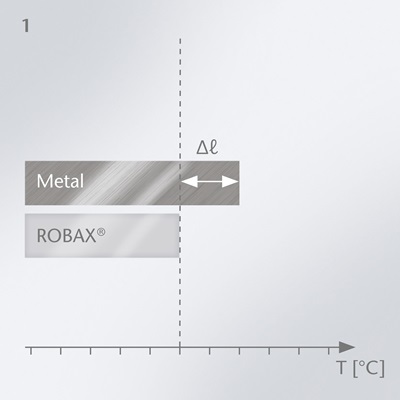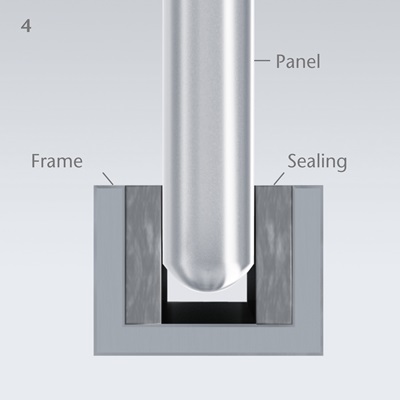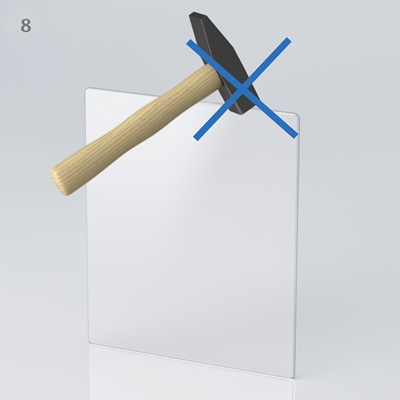Technical Details of ROBAX®
Beauty, strength and high thermal resistance
Thermal characteristics
ROBAX® glass-ceramic panels show a near-zero thermal expansion even under thermal load.
Coefficient of mean linear thermal expansion
α ₍₂₀₋ ₇₀₀°C / 68 - 1292 °F) (0 ± 0.5) x 10 ⁻ ⁶/K
Resistance to temperature differences (RTD)
The RTD value measures how well a material can resist temperature differences within a defined area. For example, the temperature difference between the hot area in the center of a panel and the cold edge or frame area (room temperature). No breakage caused by thermal stress occurs at a maximum temperature of Tmax ≤ 700 °C (1,292 °F).
Resistance to thermal shock (RTS)
The RTS value measures a hot panel’s ability to withstand a sudden thermal shock by cold water (15 °C/ 59 °F). No breakage caused by thermal stress occurs at a maximum temperature of Tmax ≤ 700 °C (1,292 °F).
Temperature/time loading
The temperature/time loading limits determine the permissible temperature for set usage times at which no breakage caused by thermal stress occurs. The temperature values refer to the hottest points on the outside of the panel.
One must make sure that these temperature/time loading limits are not exceeded. Taking resistance to thermal gradients and thermal shock into account, the following applies:
| 610 °C (1,130 °F) | 1,000 hours |
Mechanical characteristics
Density
p approx. 2.6 g/cm3 (at 25°C/77°F)
Impact and flexural strength
σbB approx. 35 MPa*
* The test is carried out in accordance with DIN EN 1288 part 5, with the surface in its normal condition of use as encouraged in practice.
The impact resistance of ROBAX® depends on the kind of installation, the size and thickness of the panel, the kind of impact, the geometry of the panel, and especially on the drilled holes and their position on the ROBAX® panel.
Therefore, information on impact resistance must always be evaluated individually according to the installation situation. Please feel free to contact us if you require further support.
The flexural strength is tested in accordance with DIN EN 1288 Part 5, with the surface in the normal state of use.
Comments on mechanical properties
Values presented regarding the strength of glass and glass-ceramic must also take into account the special properties of these materials.
In the technical sense, glass and glass-ceramic are ‘ideally elastic’, yet brittle materials in which there are no flow patterns. When they come into contact with materials of the same hardness, this causes surface damage in the form of fine nicks and cracks. When glass and glass-ceramic are subjected to a mechanical load, the build-up of critical stress at the points of such nicks and cracks cannot be relieved by plastic flow, as is possible with materials like metals.
The consequence of this behavior is that the structurally based high strength of glass and glass-ceramic (≥ 10,000 N/mm²) is practically irrelevant. It is reduced by the effect of unavoidable surface defects (in the case of unprotected surfaces) to a practical value of approx. 20 to 200 N/mm² bending strength, depending on the surface state and test conditions. This must be taken into account accordingly during installation and handling.
The strength of glass and glass-ceramic is therefore not a material constant (as its density, for example), but is dependent on the following criteria:
- Processing condition of the panel (incl. edge finish, boreholes, etc.)
- Usage condition (type and distribution of surface defects)
- Time-related conditions or alternatively the duration of the effective load
- Surrounding conditions (corrosive substances, such as hydrofluoric acid)
- The area subject to load, as well as the thickness of the panel
- The installation method of the panel
Its strength is also subject to a statistical distribution in accordance with the type and distribution of the surface defects.
Chemical characteristics
The chemical composition of ROBAX® complies with the requirements for a glass-ceramic in accordance with EN 1748 part 2. The special glass is produced of mainly natural raw materials and can therefore be used as raw material for the glass-ceramic production.
Chemical resistance
In addition ROBAX® is tested for chemical resistance as follows:
- Water resistance (hydrolytic resistance to ISO 719 grain class): HBG 1
- Acid resistance (DIN 12116): Min. class S2
- Alkali resistance (in line with ISO 695): Min. class A1
ROBAX® has a high degree of resistance to surface attacks. In individual cases, however, surfaces can experience changes under critical conditions, such as corrosive combustion gases (formation of acid at high temperatures). In such cases, please contact us.
Our application service and contribution to the environment
We can assist you in using ROBAX® panels in your fireplaces in the best way.
In our well-equipped application center we have the ability to analyze your fireplace, e.g.
- Heat emission of a new coating compared to standard ROBAX®
- Heat distribution on the glass-ceramic
- Measurement of emissions
- Improvement of mounting conditions and frame construction
After a first meeting with our application team to see how we can help you with your technical needs and product development, we will send you an offer.
- Even under thermal load, ROBAX® glass-ceramic panels show near-zero thermal expansion. For this reason, the different thermal expansion of the various framing materials in relation to the ROBAX® fire-viewing panel must be taken into consideration for the design of the entire fireplace.
- Additionally, the possible manufacturing tolerances of the frame and the glass-ceramic panel have to be considered.
- Contact pressure which leads to bending stress on the panel must be eliminated. This can be achieved, for example, by limiting torque or with a limiter which limits screw-in depth.
- As a marginal torsion of the frame construction cannot be excluded it must be prevented that this torsion is transmitted onto the ROBAX® panel by using a thermally stable, permanently elastic sealing (such as fiberglass or mineral fiber fabrics).
- If – due to constructive reasons – the pressing of the fire-viewing panel in the frame is inevitable, then the contact pressure must be evenly distributed (never at single points) over the circumference of the panel.
- The panel must not come into direct contact with metal frame parts. Also here, it is recommended to use a thermally stable, permanently elastic seal.
- Additionally, the instructions of the seal manufacturers must be followed, particularly with regard to contact pressure of materials.
- During installation, it is essential to protect the glass-ceramic panel from potential damage (impacts, bumps and scratches), especially the edge areas.
- Generally, SCHOTT advises against gluing the fire-viewing panel. Nevertheless, if a high-temperature-resistant silicone is applied circumferentially on the panel, the elastic limit of the silicone must be considered. Due to the excellent bonding properties of glass to silicone, exceeding the elastic limit can lead to cracked or broken glass-ceramic panels. Punctual gluing with high temperature-resistant silicone is possible for sealing purposes.




Gabrielle Bouren
Sales Manager SCHOTT ROBAX®